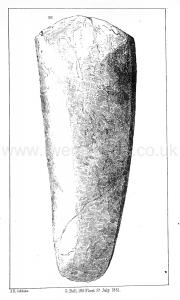Antiquities Found Near Avebury
Antiquities Found Near Avebury is in Diary of a Dean by John Merewether.
The following Sketches represent interesting Objects of Antiquity found in the neighbourhood of Avebury, which for the most part are still retained and highly prized by those on whose property they were discovered.
No. 1 . A well-burnt urn of thin red pottery, found in a barrow on the south of Beckhampton, towards Tan Hill, at the head of a skeleton lying at full length; round it were nail-heads, as if of a coffin; a few feet from this was a smaller skeleton doubled up. Height of the urn 4⅛ inches, diameter (largest) 2⅝ inches.
2 . Small urn, 4½ inches in diameter, and 2 inches high, found in a barrow to the south-east of Kennett, round which were twelve skeletons ranged with their feet towards the centre, in which the urn was placed.
3 and 4. Found in a barrow on Windmill Hill, with seven skeletons. Diameter of urn 4 inches, length of stone hammer 5 inches.
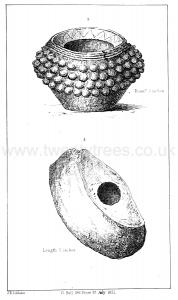
5. This urn, remarkable for its unique pattern of ornament, and proportions, being much broader and flatter than usual, and in diameter at the base no less than 5 inches, whilst it is only 6½ high, was found by workmen employed to obtain materials for husbandry purposes, from a barrow about a mile from Beckhampton, on the right-hand side of the Devizes road, containing burnt bones. When brought home it was nearly perfect; but having been placed at the front door, a beggar, whose importunities were not listened to, broke it with his stick.
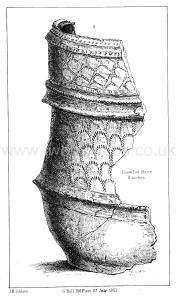
6 . A small unornamented urn of unburnt bluish clay, was found in a barrow about a quarter of a mile to the north of the former. Its diameter is 4 inches, its height 2½.
7 . A small plain urn, found in the same barrow, and of similar material. Near it was the skull of a very young person. It is very remarkable, that where the bones of young persons are found, this form of urn is usually observed. Its diameter is 4½ inches, its height 7 inches. In cases where such remains have been accidentally found by labourers, it is difficult to ascertain the exact position and accompaniments. It has been my object to give, as accurately as possible, the account which I received.
8. An urn of brown unbaked clay, of similar form and dimensions with the last, but with somewhat more ornament, found about a mile and a half west of the former, in a barrow, about 2 feet from the knees of the skeleton figure at No. 16, and not more than 18 inches below the surface of the turf.
9. An urn, 7 inches high by 4½ in diameter, found in digging clay for a pond, near Roundaway Down, without any irregularity of the ground, but near a skeleton, whose position could not be ascertained, having been carelessly disturbed by the workmen.
10. A beautiful and perfect urn, 6½ inches high by 3⅝ in diameter, of unburnt clay, found at the head of a skeleton in a crouched posture, and in an oval cist formed in the chalk, and covered with the same finely powdered. This is introduced as being the first of the kind I ever saw, and as having been discovered in the presence of Sir Richard Colt Hoare. Its locality was near the Beckhampton and Devizes road, a few yards only from Wansdyke and Shepherd's Shore, south-westward.
11. Fragments of a very large unburnt urn, having the peculiarity of a handle; its diameter must have been at least 18 inches. It was found at the large oval barrow to the south of "the Pennings" belonging to Mr. George Brown, above Beckhampton; contained burnt bones and a piece of bronze (No. 23), probably a spear-head. This barrow has been on several occasions reduced for purposes of husbandry, and has generally produced such relics. It appears to have been used at different periods as a place of sepulture, and might yet repay further investigation. "The Pennings" is a term at present applied, as the cursory observer would suppose, to a farm-yard and fold near at hand; but the phrase belongs to a disused enclosure adjoining, of a double square in form, and of some extent, surrounded by a slight ditch and mound, on which still grow manv stunted whitethorn bushes. The term "Pennings." is applied by the husbandmen to other similar enclosures and earthworks.
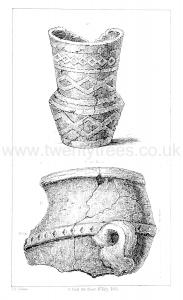
12. An urn of usual dimensions, 7 inches high, found in a barrow of low elevation, a short distance south of a remarkable long barrow, already described as made up of circular and convex sarsen stones, to the south of Kennett, at the feet of a skeleton lying towards the west, and in a regularly-formed cist.
13. A bronze spear-head, found with the above, 4 inches long.
14. A stone hatchet of compact bluish stone, resembling lias, also in the same, five inches long.
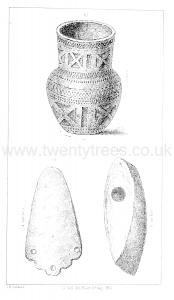
15. Posture of a skeleton found in Morgan's Hill above Wansdyke, without any barrow or irregularity of the surface of the ground, 18 inches below the turf.
16. Posture of a skeleton found with No. 8.
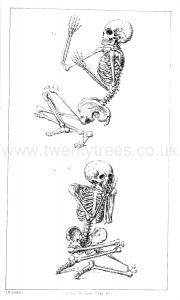
17 . Iron spear-head, found in breaking up the down for cultivation, about a mile and a half to the right of the Beckhampton and Devizes road, taken at right angles to that road, about a mile from Beckhampton turnpike; 9 inches below the surface.
18. A lock of iron, with two keys, found very near the last mentioned, in ploughing up the same land.
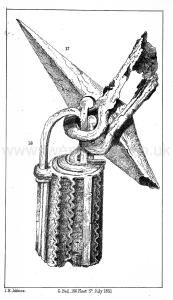
19. Horseshoe found a short distance north-west of Silbury Hill, with other horseshoes, and a skeleton.
20. Bronze spear-head found in digging flints in the down south-west of Beckhampton, with back earth round it, but without any irregularity of ground. Full size of original, as are the following, to No. 33.
21 and 22. Bone pins found in digging flints on the same down.
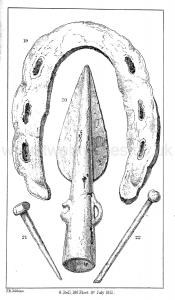
23. Bronze spear-head found with No. 11.
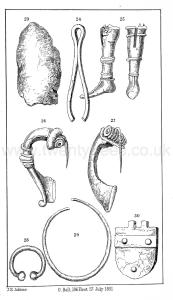
24. Bronze tweezers.

25 [Map]. Side and front view of a singular bronze leg, having a groove to make a joint at the knee, and riveted to either limb. These bronze articles were found very near the line of the Roman road (Via Badonica). Could this be part of such a figure as we read of in Petronius? "Larvam argenteam attulit servus, sic aptatam ut articuli ejus vertebreeque laxatse in omnem partem verterentur," &c., pp. 115, 116. [The servant brought a silver skeleton, so fitted that its joints and vertebrae were loosened and turned in every direction]

26, 27, 28, 29, 30. Bronze fibulae, &:c., all found in the same immediate neighbourhood, in digging flints on the down-lands.

31. Portion of a gold torque found in digging flints on Allington down, near the highest point of the hills bounding the north side of Pewsey vale; size of the original, weight oz. troy. The original is in the possession of the Earl of Ilchester, who claimed it as treasure trove, being lord of the manor.
32. Iron spear-head found in digging rubble to make roads on the down, where there was no irregularity of surface, at Lower Upham, parish of Auburn.
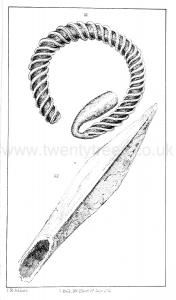
33. Stags' horns: above the burr, circumference 10½ inches, at the top 7½.
34. Above the burr 6 inches circumference; length of tine 6½ inches.
35. Horn of a smaller animal, and more decayed, 8½ inches long. These were found on the neighbouring downs in digging flints.
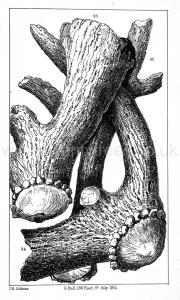
36. Portions of gold ornaments found in a barrow on Roundaway down, near Devizes. The barrow in question was opened by the orders of the late proprietor, E. F. Colston, Esq., of Roundaway Park. It is a small one, situated in the apex of the down, which, although particularly mentioned by Sir R. C. Hoare, escaped the examination of that able and indefatigable antiquary. The workmen having, at a depth of 7 feet, cut through an upper stratum of peculiarly fine dark mould, and reached the natural chalk level, came to a skeleton, much decayed, which had formerly been enclosed in a wooden chest, bound round and clamped together with strong iron plates or hoops. Several portions of this iron-work had fibres of the wood still adhering to them, and remained precisely as originally placed. The skeleton lay east and west, the head towards the latter point. At its feet, formed of about twenty triangular pieces of brass fastened together with rivets and two thin hoops of the same metal, lay a cap or helmet, which remained perfect a few minutes only, falling to pieces on the admission of air. Near the neck were several large oval garnets, among which was one, much larger than the rest, of a triangular shape. All were strongly set in gold. The ovals appeared to form, with intermediate beads made of twisted gold wire, a necklace, from which the triangular stone hung as the central pendant. There were also (with several smaller articles) two pins of gold, fastened to one another by a gold chain, with a small medallion between them; on one side of which is distinctly engraved the figure of the Cross. Unfortunately none of the parties most interested in the discovery were present at the exact time, and it is feared that they did not obtain all the remains, as it was heard that similar stones had subsequently been sold at Bath, which had been found on Roundaway down. The bones of four animals were also found in the corners, said to be of a dog and cat, a horse and a boar. A coin, small brass, of Crispus, was also found, proving the date of the interment. There is no other instance on record of a similar discovery belonging to the same period in this district.
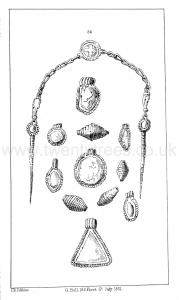
37 . A celt of brass, extremely perfect, and of metal remarkable for its dark colour, found at Ramsbury, Wilts, in digging peat. This, the first article of antiquity possessed by the writer, was purchased for half-a-crown, when schoolboy at Ramsbury.
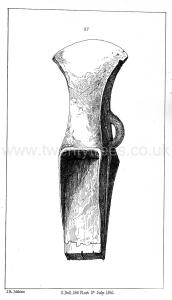
38. A celt of flint, elaborately worked, and the greater part bearing a high polish, found in grubbing up a hedgerow on a bank in the parish of Stanton Fitz-Warren, Wilts. Both the size of the originals.
